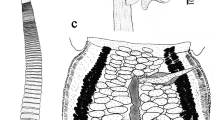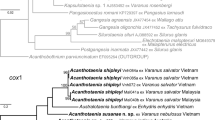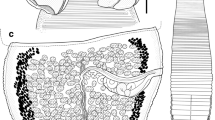Abstract
A new lecanicephalidean species of Aberrapex Jensen, 2001 is described from the blue-spotted fantail ray Taeniura lymma (Forsskål) collected off the eastern coast of Sabah in Malaysian Borneo. This is the first record of a lecanicephalidean tapeworm from the island of Borneo and the first record of Aberrapex from this host species. A. manjajiae n. sp. is easily distinguished from its two congeners, A. senticosus Jensen, 2001 and A. arrhynchum (Brooks, Mayes & Thorson, 1981) Jensen, 2001, based on its overall smaller size (928–1,971 vs 1,485–6,333 and up to 3,350μm long, respectively) and fewer testes (10–19 vs 20–40 and 18–25, respectively). In addition, A. manjajiae n. sp. is readily distinguished from A. senticosus based on a more anteriorly positioned genital pore (76–85 vs 52–72% of proglottid length from posterior end) and its distal bothridial microthrix pattern. A. manjajiae n. sp. can be further distinguished from A. arrhynchum based on its smaller scolex (82–101 × 119–164 vs 177–186 × 233–326μm). The host distribution of Aberrapex is expanded from the Myliobatidae to include the Dasyatidae.
Similar content being viewed by others
References
Carpenter, K.E., Niem, V.H. (Eds) (1999) FAO species identification guide for fisheries purposes. The living marine resources of the Western Central Pacific. Volume 3. Batoid fishes, chimaeras and bony fishes part 1 (Elopidae to Linophrynidae). Rome: FAO, pp. 1397–2068
Compagno L.J.V., Last P.R. (1999) Dasyatidae. In: Carpenter K.E., Niem V.H., (eds), FAO species identification guide for fisheries purposes. The living marine resources of the Western Central Pacific. Volume 3. Batoid fishes, chimaeras and bony fishes part 1 (Elopidae to Linophrynidae). FAO, Rome, pp. 1479–1505
Hassan S. (1982) Polypocephalus saoudi n. sp. Lecanicephalidean cestode from Taeniura lymma in the Red Sea. Journal of the Egyptian Society of Parasitology 12:395–401
Jensen K. (2001) Four new genera and five new species of lecanicephalideans (Cestoda: Lecanicephalidea) from elasmobranchs in the Gulf of California. Journal of Parasitology 87:845–861
Jensen K. (2005) A monograph on the Lecanicephalidea (Platyhelminthes, Cestoda). Bulletin of the University of Nebraska State Museum 18:1–241
Last P.R., Stevens J.D. (1994) Sharks and rays of Australia. CSIRO, Australia, pp. 513
Palm H.W. (2004) The Trypanorhyncha Diesing, 1863. PKSPL-IPB Press, Bogor, pp. 710
Ramadan M.M. (1984) A review of the cestode genus Rhinebothrium Linton, 1889 (Tetraphyllidae), with a description of two new species of the sting ray Taeniura lymma from the Red Sea. Journal of the Egyptian Society of Parasitology 14:85–94
Ramadan M.M. (1986) Cestodes of the genus Cephalobothrium Shipley and Hornel, 1906 (Lecanicephaliidae), with description of C. ghardagense n. sp. and C. taeniurae n. sp. from the Red Sea fishes. Japanese Journal of Parasitology 35:11–15
Saoud M.F.A. (1963) On a new cestode, Anthobothrium taeniuri n.sp., (Tetraphyllidea) from the Red Sea sting ray and the relationship between Anthobothrium van Beneden, 1850, Rhodobothrium Linton, 1889 and InermiphyllidiumRiser, 1955. Journal of Helminthology 37:135–144
Saoud M.F.A., Ramadan M.M., Hassan S.I. (1982) On Echinobothrium helmymohamedi n. sp. (Cestoda: Diphyllidea); a parasites of the sting ray Taeniura lymma from the Red Sea. Journal of the Egyptian Society of Parasitology 12:199–207
Tyler, G. (2001) A monograph on the Diphyllidea (Platyhelminthes: Cestoda). PhD Dissertation, University of Connecticut, 390 pp
Williams H.H. (1964) Some new and little known cestodes from Australian elasmobranchs with a brief discussion on their possible use in problems of host taxonomy. Parasitology 54:737–748
Acknowledgements
I thank Rayner Datuk Stuel Galid, Director of the Department of Fisheries, Sabah, Malaysia for his logistical assistance, as well as Mohd. Tahir Hj. Ahmad, Mohamad Sappan, Aldam Jalil and Maidin Osman from the Semporna Office of the Department of Fisheries, Sabah, Malaysia for their valuable assistance in obtaining specimens. I␣am particularly grateful to Dr␣Janine Caira for organising the collecting in Sabah and for her participation in the fieldwork conducted for this study. I am also grateful to Loren Caira and Dr␣Gavin Naylor for the collection of the hosts, and to Garrett Call for his assistance with specimen preparation. These collections were conducted under permit No. UPE:40/200/19SJ.925 from the Economic Planning Unit in Kuala Lumpur and permit No. JKM 100–24/13/1/223(59) from the Chief Minister’s Department, Kota Kinabalu, Sabah, Malaysia. This work was supported with funds from NSF BS&I grant No. DEB 0103640 to J. N. Caira, G. Naylor, P. Last, J. Stevens and KJ.
Author information
Authors and Affiliations
Corresponding author
Rights and permissions
About this article
Cite this article
Jensen, K. A new species of Aberrapex Jensen, 2001 (Cestoda: Lecanicephalidea) from Taeniura lymma (Forsskål) (Myliobatiformes: Dasyatidae) from off Sabah, Malaysia. Syst Parasitol 64, 117–123 (2006). https://doi.org/10.1007/s11230-005-9026-2
Received:
Accepted:
Published:
Issue Date:
DOI: https://doi.org/10.1007/s11230-005-9026-2




